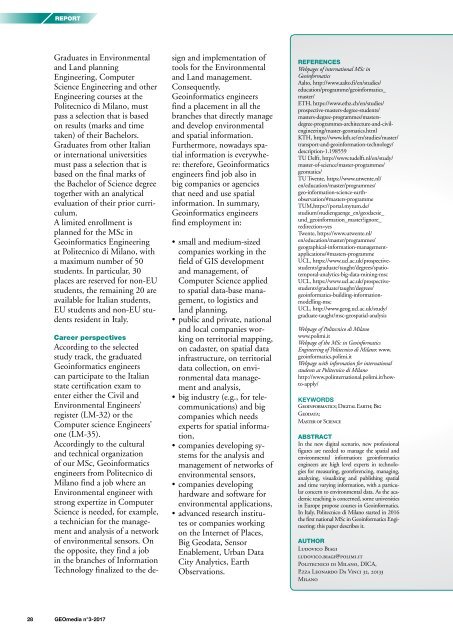GEOmedia 3 2017
You also want an ePaper? Increase the reach of your titles
YUMPU automatically turns print PDFs into web optimized ePapers that Google loves.
REPORT<br />
Graduates in Environmental<br />
and Land planning<br />
Engineering, Computer<br />
Science Engineering and other<br />
Engineering courses at the<br />
Politecnico di Milano, must<br />
pass a selection that is based<br />
on results (marks and time<br />
taken) of their Bachelors.<br />
Graduates from other Italian<br />
or international universities<br />
must pass a selection that is<br />
based on the final marks of<br />
the Bachelor of Science degree<br />
together with an analytical<br />
evaluation of their prior curriculum.<br />
A limited enrollment is<br />
planned for the MSc in<br />
Geoinformatics Engineering<br />
at Politecnico di Milano, with<br />
a maximum number of 50<br />
students. In particular, 30<br />
places are reserved for non-EU<br />
students, the remaining 20 are<br />
available for Italian students,<br />
EU students and non-EU students<br />
resident in Italy.<br />
Career perspectives<br />
According to the selected<br />
study track, the graduated<br />
Geoinformatics engineers<br />
can participate to the Italian<br />
state certification exam to<br />
enter either the Civil and<br />
Environmental Engineers’<br />
register (LM-32) or the<br />
Computer science Engineers’<br />
one (LM-35).<br />
Accordingly to the cultural<br />
and technical organization<br />
of our MSc, Geoinformatics<br />
engineers from Politecnico di<br />
Milano find a job where an<br />
Environmental engineer with<br />
strong expertize in Computer<br />
Science is needed, for example,<br />
a technician for the management<br />
and analysis of a network<br />
of environmental sensors. On<br />
the opposite, they find a job<br />
in the branches of Information<br />
Technology finalized to the design<br />
and implementation of<br />
tools for the Environmental<br />
and Land management.<br />
Consequently,<br />
Geoinformatics engineers<br />
find a placement in all the<br />
branches that directly manage<br />
and develop environmental<br />
and spatial information.<br />
Furthermore, nowadays spatial<br />
information is everywhere:<br />
therefore, Geoinformatics<br />
engineers find job also in<br />
big companies or agencies<br />
that need and use spatial<br />
information. In summary,<br />
Geoinformatics engineers<br />
find employment in:<br />
• small and medium-sized<br />
companies working in the<br />
field of GIS development<br />
and management, of<br />
Computer Science applied<br />
to spatial data-base management,<br />
to logistics and<br />
land planning,<br />
• public and private, national<br />
and local companies working<br />
on territorial mapping,<br />
on cadaster, on spatial data<br />
infrastructure, on territorial<br />
data collection, on environmental<br />
data management<br />
and analysis,<br />
• big industry (e.g., for telecommunications)<br />
and big<br />
companies which needs<br />
experts for spatial information,<br />
• companies developing systems<br />
for the analysis and<br />
management of networks of<br />
environmental sensors,<br />
• companies developing<br />
hardware and software for<br />
environmental applications,<br />
• advanced research institutes<br />
or companies working<br />
on the Internet of Places,<br />
Big Geodata, Sensor<br />
Enablement, Urban Data<br />
City Analytics, Earth<br />
Observations.<br />
REFERENCES<br />
Webpages of international MSc in<br />
Geoinformatics<br />
Aalto, http://www.aalto.fi/en/studies/<br />
education/programme/geoinformatics_<br />
master/<br />
ETH, https://www.ethz.ch/en/studies/<br />
prospective-masters-degree-students/<br />
masters-degree-programmes/mastersdegree-programmes-architecture-and-civilengineering/master-geomatics.html<br />
KTH, https://www.kth.se/en/studies/master/<br />
transport-and-geoinformation-technology/<br />
description-1.198559<br />
TU Delft, http://www.tudelft.nl/en/study/<br />
master-of-science/master-programmes/<br />
geomatics/<br />
TU Twente, https://www.utwente.nl/<br />
en/education/master/programmes/<br />
geo-information-science-earthobservation/#masters-programme<br />
TUM,https://portal.mytum.de/<br />
studium/studiengaenge_en/geodaesie_<br />
und_geoinformation_master?ignore_<br />
redirection=yes<br />
Twente, https://www.utwente.nl/<br />
en/education/master/programmes/<br />
geographical-information-managementapplications/#masters-programme<br />
UCL, https://www.ucl.ac.uk/prospectivestudents/graduate/taught/degrees/spatiotemporal-analytics-big-data-mining-msc<br />
UCL, https://www.ucl.ac.uk/prospectivestudents/graduate/taught/degrees/<br />
geoinformatics-building-informationmodelling-msc<br />
UCL, http://www.geog.ucl.ac.uk/study/<br />
graduate-taught/msc-geospatial-analysis<br />
Webpage of Politecnico di Milano<br />
www.polimi.it<br />
Webpage of the MSc in Geoinformatics<br />
Engineering of Politecnico di Milano: www.<br />
geoinformatics.polimi.it<br />
Webpage with information for international<br />
students at Politecnico di Milano<br />
http://www.polinternational.polimi.it/howto-apply/<br />
KEYWORDS<br />
Geoinformatics; Digital Earth; Big<br />
Geodata;<br />
Master of Science<br />
ABSTRACT<br />
In the new digital scenario, new professional<br />
figures are needed to manage the spatial and<br />
environmental information: geoinformatics<br />
engineers are high level experts in technologies<br />
for measuring, georeferencing, managing,<br />
analyzing, visualizing and publishing spatial<br />
and time varying information, with a particular<br />
concern to environmental data. As the academic<br />
teaching is concerned, some universities<br />
in Europe propose courses in Geoinformatics.<br />
In Italy, Politecnico di Milano started in 2016<br />
the first national MSc in Geoinformatics Engineering:<br />
this paper describes it.<br />
AUTHOR<br />
Ludovico Biagi<br />
ludovico.biagi@polimi.it<br />
Politecnico di Milano, DICA,<br />
P.zza Leonardo Da Vinci 32, 20133<br />
Milano<br />
28 <strong>GEOmedia</strong> n°3-<strong>2017</strong>


















